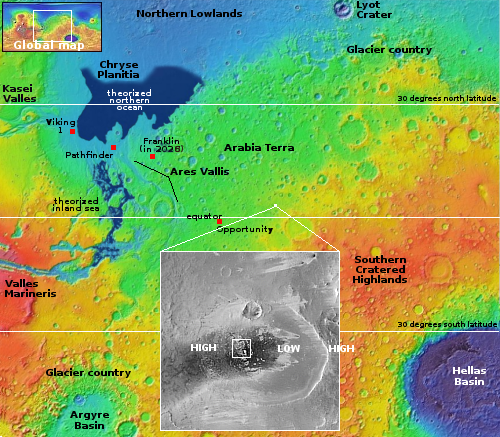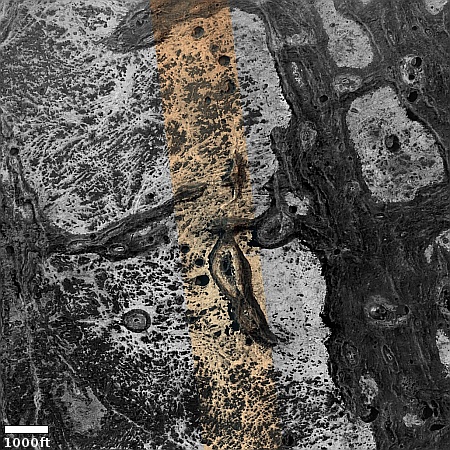Another “What the heck?!” image on Mars
Cool image time! The picture to the right, cropped, reduced, and sharpened to post here, was taken on March 2, 2025 by the high resolution camera on Mars Reconnaissance Orbiter (MRO).
The scientists label this “Monitoring Irregular Terrains in Western Arabia Terra.” I label it more bluntly as another one of MRO’s “What the heck?!” images. For all I know, this is nothing more than a discarded Vincent Van Gogh painting, thrown out because even he couldn’t figure out what he was painting.
The best guess I can make, just from the picture alone, is that some of the dark spots are vents from which the white stuff vented at some point, either as small lava or mud volcanoes. As the location is close to the equator, near surface ice is almost certainly not a factor in what we see.
In any case there is no way to reasonably decipher this picture, just by looking at the picture. It is necessary to take a wider view.

The white dot on the overview map to the right marks the location, on the southeastern edge of Arabia Terra, Mars’ largest transition zone between the northern lowland plains and the southern cratered highlands.
The rectangle in the inset indicates the area covered by the picture above. This strange landscape appears to be inside a faint 13-mile-wide crater, except that this is not an impact crater. No raised rim of ejecta, and the low point, about 1,000 feet down, is offset from the center, as I have indicated in the inset.
My best guess is that this crater is actually a volcanic vent or small caldera, with the most recent area of venting the area of this weird landscape. Though it is likely that there has been no activity here for eons, the scientists are now monitoring this site for changes over time. The first MRO high resolution image was taken one year ago, with this more recent image a follow-up. No obvious changes are noticeable based on my quick cursory comparison, but that can’t be trusted, especially since the resolution of the jpgs available on the web is not the highest taken by MRO.
The details in the inset also suggest that the prevailing winds are blowing from the east to the west, and could also have played a factor in painting this landscape.
Maybe Van Gogh did have something to do with it, in spirit.
On Christmas Eve 1968 three Americans became the first humans to visit another world. What they did to celebrate was unexpected and profound, and will be remembered throughout all human history. Genesis: the Story of Apollo 8, Robert Zimmerman's classic history of humanity's first journey to another world, tells that story, and it is now available as both an ebook and an audiobook, both with a foreword by Valerie Anders and a new introduction by Robert Zimmerman.
The print edition can be purchased at Amazon or from any other book seller. If you want an autographed copy the price is $60 for the hardback and $45 for the paperback, plus $8 shipping for each. Go here for purchasing details. The ebook is available everywhere for $5.99 (before discount) at amazon, or direct from my ebook publisher, ebookit. If you buy it from ebookit you don't support the big tech companies and the author gets a bigger cut much sooner.
The audiobook is also available at all these vendors, and is also free with a 30-day trial membership to Audible.
"Not simply about one mission, [Genesis] is also the history of America's quest for the moon... Zimmerman has done a masterful job of tying disparate events together into a solid account of one of America's greatest human triumphs."--San Antonio Express-News
Cool image time! The picture to the right, cropped, reduced, and sharpened to post here, was taken on March 2, 2025 by the high resolution camera on Mars Reconnaissance Orbiter (MRO).
The scientists label this “Monitoring Irregular Terrains in Western Arabia Terra.” I label it more bluntly as another one of MRO’s “What the heck?!” images. For all I know, this is nothing more than a discarded Vincent Van Gogh painting, thrown out because even he couldn’t figure out what he was painting.
The best guess I can make, just from the picture alone, is that some of the dark spots are vents from which the white stuff vented at some point, either as small lava or mud volcanoes. As the location is close to the equator, near surface ice is almost certainly not a factor in what we see.
In any case there is no way to reasonably decipher this picture, just by looking at the picture. It is necessary to take a wider view.

The white dot on the overview map to the right marks the location, on the southeastern edge of Arabia Terra, Mars’ largest transition zone between the northern lowland plains and the southern cratered highlands.
The rectangle in the inset indicates the area covered by the picture above. This strange landscape appears to be inside a faint 13-mile-wide crater, except that this is not an impact crater. No raised rim of ejecta, and the low point, about 1,000 feet down, is offset from the center, as I have indicated in the inset.
My best guess is that this crater is actually a volcanic vent or small caldera, with the most recent area of venting the area of this weird landscape. Though it is likely that there has been no activity here for eons, the scientists are now monitoring this site for changes over time. The first MRO high resolution image was taken one year ago, with this more recent image a follow-up. No obvious changes are noticeable based on my quick cursory comparison, but that can’t be trusted, especially since the resolution of the jpgs available on the web is not the highest taken by MRO.
The details in the inset also suggest that the prevailing winds are blowing from the east to the west, and could also have played a factor in painting this landscape.
Maybe Van Gogh did have something to do with it, in spirit.
On Christmas Eve 1968 three Americans became the first humans to visit another world. What they did to celebrate was unexpected and profound, and will be remembered throughout all human history. Genesis: the Story of Apollo 8, Robert Zimmerman's classic history of humanity's first journey to another world, tells that story, and it is now available as both an ebook and an audiobook, both with a foreword by Valerie Anders and a new introduction by Robert Zimmerman.
The print edition can be purchased at Amazon or from any other book seller. If you want an autographed copy the price is $60 for the hardback and $45 for the paperback, plus $8 shipping for each. Go here for purchasing details. The ebook is available everywhere for $5.99 (before discount) at amazon, or direct from my ebook publisher, ebookit. If you buy it from ebookit you don't support the big tech companies and the author gets a bigger cut much sooner.
The audiobook is also available at all these vendors, and is also free with a 30-day trial membership to Audible.
"Not simply about one mission, [Genesis] is also the history of America's quest for the moon... Zimmerman has done a masterful job of tying disparate events together into a solid account of one of America's greatest human triumphs."--San Antonio Express-News



That looks like the Martian terrain portrayed in “The Angry Red Planet.